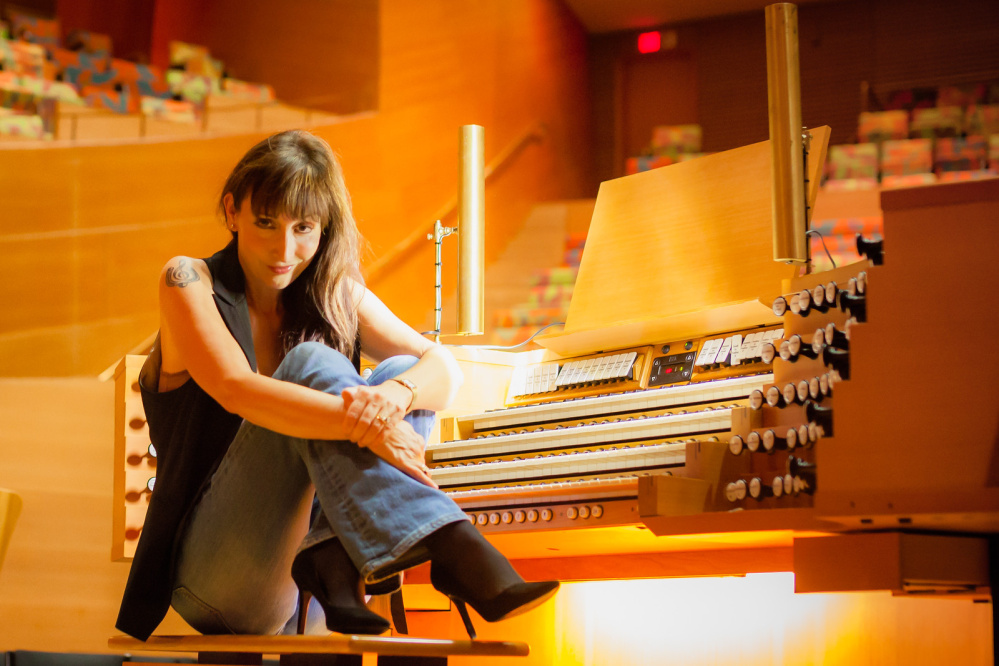At one point during Carol Williams’ recital on the Kotzschmar Organ at Merrill Auditorium on Tuesday evening, every municipal organist in the United States gathered onstage to play music by George Gershwin. Because they couldn’t fit comfortably on a single organ bench, they took turns sliding off the bench’s left edge and running around to the organ’s right side to reach over to one of the manuals, or pull out stops.
There was Williams, the municipal organist of San Diego, California. Ray Cornils, who holds the same position here in Portland, was on hand. And, well, that was it. There are only two of them, and there they were, playing a medley of Gershwin songs as if it were a Marx Brothers-inspired relay race, complete with birdsong and percussion effects.
Williams’ recital was not all frivolity, of course, and she was at her best in two thoroughly serious works. Charles Tournemire’s Te Deum, a dramatic, texturally dense set of variations on a sacred theme, let her demonstrate the organ’s darker timbres, and Max Reger’s sober Introduction and Variations put the spotlight on the deftness of Williams’ pedal work.
Exploring the Kotzschmar’s array of timbres seemed to be very much on Williams’ mind. Throughout the program, which rested heavily on her own works and arrangements, she made the most of the instrument’s contrasting light and heavy tones, to say nothing of its dynamic breadth. Her opening work, the “Official March of the Panama-California Expedition, San Diego 1915” – a quirky period piece by Fred Stansfield – let her get to it directly: Grand passages using brass stops were offset by delicate sections with muted flutes and a shimmering, music box sparkle.
Throughout the evening, Williams touched on many of the gradations between those extremes. She also offered a varied tour of compositional styles, though some were cloaked in arrangements that turned them into peculiar stylistic hybrids. In her arrangement of a suite of dances by the Renaissance composer Tielman Susato, the composer’s melodies rang through harmonizations and coloration that made them seem like late 19th century French organ works. Her rendering of “Greensleeves,” a piece from Susato’s time, was unabashedly bluesy.
In one of her introductions – she was fairly chatty – Williams offered a brief tour of the Kotzschmar’s effect stops – the bird, an antique car horn, a doorbell, church bell, train whistle, triangle and cymbal. Only one effect, a galloping horse, left her unimpressed.
Most of those ‘ turned up at some point in the program. Several, including the car horn and train whistle, adorned Williams’ arrangement of the Al Jolsen, Buddy De Sylva and Joseph Meyer classic, “California, Here I Come.”
There were occasional disappointments. Williams’ arrangement of the Overture from “The Marriage of Figaro” captures the spirit of the score and draws on timbres that mirror (more or less) Mozart’s orchestration. But she played the piece at a speedy clip that forced her to curtail phrase endings as she moved from manual to manual. If she had played the piece at the speed an orchestra typically plays it, she could have let those phrases breathe.
Williams’ own works – she played a dozen, including her encore, “Andromeda” – are pleasantly varied. Her “Spreckels Centennial Fanfare” (Op. 14), composed for the 100th anniversary of her home instrument, the Spreckels Organ in Balboa, Park, San Diego, is alternately festive and dreamy, with quotations from Beethoven’s “Ode to Joy” and “Happy Birthday.”
Often, her pieces were derivative, as if they were meditations on earlier music. Her three-movement Suite for Organ (Op. 5) begins with a neo-Medieval section that flows into a meditative central movement and an outgoing finale that called to mind some of Keith Emerson’s improvisations, and it ends with a speedy blast of Romanticism built on a rhythm from Mendelssohn’s “Italian” Symphony. You could hear echoes of Tchaikovsky, as filtered through Kim Fowley’s “Nut Rocker,” in her “Venus Toccata” (Op. 9). And her “Twilight” (Op. 3) could be mistaken for one of Philip Glass’s oscillations between major and minor keys.
Williams closed her program with a full-throttle, ‘-heavy gloss on themes from Andrew Lloyd Webber’s “Phantom of the Opera.”
Allan Kozinn is a former music critic and culture writer for The New York Times who lives in Portland. He can be contacted at:
allankozinn@gmail.com
Twitter: kozinn
Send questions/comments to the editors.



Success. Please wait for the page to reload. If the page does not reload within 5 seconds, please refresh the page.
Enter your email and password to access comments.
Hi, to comment on stories you must . This profile is in addition to your subscription and website login.
Already have a commenting profile? .
Invalid username/password.
Please check your email to confirm and complete your registration.
Only subscribers are eligible to post comments. Please subscribe or login first for digital access. Here’s why.
Use the form below to reset your password. When you've submitted your account email, we will send an email with a reset code.